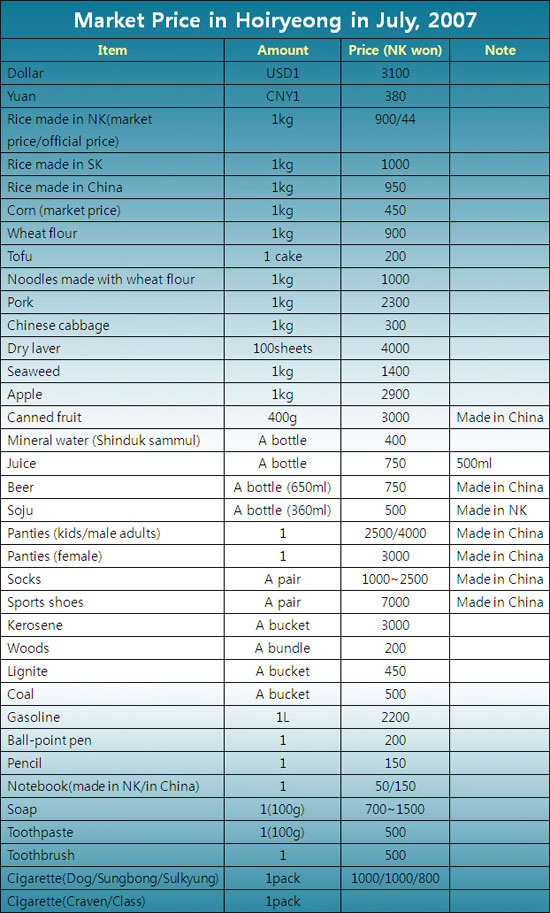Daily NK
Kim Young Jin
7/12/2007
 The North Korean jangmadang’s (market) rice price has narrowly increased after the spring shortage season.
The North Korean jangmadang’s (market) rice price has narrowly increased after the spring shortage season.
As a result of DailyNK’s investigation of price levels in Northern cities of North Korea at the end of June and beginning of July, the price of North Korean rice is 900 won per kilogram which has increased 80 won compared to its price at the end of March.
At the jangmadang in Shinuiju, North Pyongan, the price of rice, compared to three months ago, has been sold at a 120 won higher price at 980 won. North Korea’s spring shortage season is around March to May before the barley harvest, after the passage of spring.
The reason why the price of rice has shown a narrow upward tendency of 100 won domestically is that along with the effects of the spring shortage season, the nationwide “farm supporting combat” was implemented last May. During the farm supporting period, the jangmadang was closed out, so it became difficult to obtain rice.
Further, with the delay in South Korea’s support of 40,000 tons of rice to North Korea, the increase in the price of rice seems to have been fueled. The price of South Korean rice, compared to the end of March, increased over 150 won. South Korean rice was sold at the increased price of 1,100 in the Shinuiju region.
Along with the increase in the price of rice, the exchange rate seems to show a slight increase as well. In Hoiryeong, it increased by 50 won, compared to the end of March, according to the basis of 3,100 won per dollar. The Chinese Yuan was sold at a 390 won line, having increased 20 won.
Besides this, the staple of North Korea’s lower-class, corn, compared to the end of March, increased by approximately 80 won to 450 won per kilogram. With the rise in the price of rice, the demand for corn as a substitute ration seems to have increased as a result. Frozen pollack, which cost 4,000 won per one, went down to 3,500 won.
Chinese-made shoes, compared to March, is being sold for 7,000 won per pair, having decreased around 5,000 won. In addition, the price of Chinese industrial products as a whole is showing a decline.
Due to North Korean merchants who received goods through Korean-Chinese peddlers in the past going over to China themselves and obtaining goods through dumping, the drop in prices has been continuing.
Pork (2,300 won per kg) or cabbage (300 won per kg) and the price of other vegetables, compared to the end of March, declined by 200 won. In the case of fruits, the price of apples skyrocketed by 1,400 won from three months ago to 2,900 won per kilogram.
Also, among North Korean cigarettes, a product with the brand “Dog” recently surfaced. The price is the same as “Sunbong” at 1,000 won. The representative foreign brand “Craven (called ‘Cat’ in North Korea)” narrowly declined to 1,300 won.
Cost of DPRK grains up as lean season continues
Institute for Far Eastern Studies (IFES)
NK Brief No. 07-7-16-1
7/16/007
The results of a general survey of market prices in the northern region of North Korea carried out by the “Daily NK” show that grain prices continue to rise. The survey, taken from the end of June to the beginning of July, showed that the price per kilogram of domestic rice was 900 Won, 80 Won higher than at the end of March. Sinuiju market prices have risen 120 Won over the last three months, with rice now selling for 980 Won per kilogram.
The ‘lean season’ in North Korea runs from the spring and lasts 3 to 5 months into the summer until barley crops are ready for harvesting. The rise in rice costs by around 100 Won appears to be due to a combination of factors, one being the influence of the lean season, and another being the mobilization of city residents to farming communities to help with harvesting. During harvesting season, markets are closed as workers are sent to the fields, making it difficult to purchase rice. In addition, the decision by Seoul to delay delivery of 400 thousand tons of aid has further aggravated the situation. The price of South Korean rice in the North has also risen, up 150 Won since March in some areas, and up as much as 250 Won in Sinuiju, where a kilogram of ROK rice sells for 1,100.
The rising cost of rice is fueling demand for substitute grains, causing their prices to rise as well. Corn, a staple food for low-income DPRK families, has risen 80 Won since March, to now sell for 450 Won per kilogram. In addition to rising grain prices, currency exchange rates also appear to be on the rise. In the city of Hyeryung, one USD is worth 3,100 Won, 50 Won more than in March. The Chinese Yuan has risen 20 Won, and now trades for 390 Won.
On the other hand, the prices of some goods in the markets are falling. In particular, Chinese goods are becoming more available, thus lowering costs. Chinese shoes have fallen to 7,000 Won, 5,000 Won less than the price in March. Previously, goods were brought into the country only through Chinese-Korean cross-border traders, but now North Korean vendors have direct access to Chinese goods being ‘dumped’ in the North, causing their prices to continue to decline.

